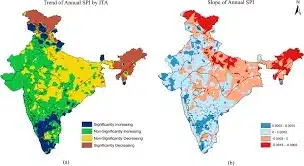About Standardised Precipitation Index:
- It is used for estimating wet or dry condition based on precipitation variable.
- The SPI calculation is based on the long-term precipitation record for a particular location and long-term period (longer than 30 years is desirable).
- This index is negative for drought and positive for wet conditions. As the dry or wet conditions become more severe, the index becomes more negative or positive respectively.
- Time scale: It includes timescales of 1, 2, 3, 6, 9, 12, 24, 36, 48, 60 and 72 months.
Key points about India Meteorological Department
- It was established in 1875. It is the National Meteorological Service of the country and the principal government agency in all matters relating to meteorology and allied subjects.
- There are 6 Regional Meteorological Centres, each under a Deputy Director General with headquarters at Mumbai, Chennai, New Delhi, Calcutta, Nagpur and Guwahati.
- Mandate:
- To take meteorological observations and to provide current and forecast meteorological information for optimum operation of weather-sensitive activities like agriculture, irrigation, shipping, aviation, offshore oil explorations, etc.
- To warn against severe weather phenomena like tropical cyclones, norwesters, dust storms, heavy rains and snow, cold and heat waves, etc., which cause destruction of life and property.
- To provide meteorological statistics required for agriculture, water resource management, industries, oil exploration and other nation-building activities.
- To conduct and promote research in meteorology and allied disciplines.
- Nodal ministry: Ministry of Earth Sciences (MoES)
- Headquarter: New Delhi.
Q1: What is Precipitation?
It is any liquid or frozen water that forms in the atmosphere and falls back to the earth. It comes in many forms, like rain, sleet, and snow. Along with evaporation and condensation, precipitation is one of the three major parts of the global water cycle.
Last updated on June, 2025
→ UPSC Notification 2025 was released on 22nd January 2025.
→ UPSC Prelims Result 2025 is out now for the CSE held on 25 May 2025.
→ UPSC Prelims Question Paper 2025 and Unofficial Prelims Answer Key 2025 are available now.
→ UPSC Calendar 2026 is released on 15th May, 2025.
→ The UPSC Vacancy 2025 were released 1129, out of which 979 were for UPSC CSE and remaining 150 are for UPSC IFoS.
→ UPSC Mains 2025 will be conducted on 22nd August 2025.
→ UPSC Prelims 2026 will be conducted on 24th May, 2026 & UPSC Mains 2026 will be conducted on 21st August 2026.
→ The UPSC Selection Process is of 3 stages-Prelims, Mains and Interview.
→ UPSC Result 2024 is released with latest UPSC Marksheet 2024. Check Now!
→ UPSC Toppers List 2024 is released now. Shakti Dubey is UPSC AIR 1 2024 Topper.
→ Also check Best IAS Coaching in Delhi
























